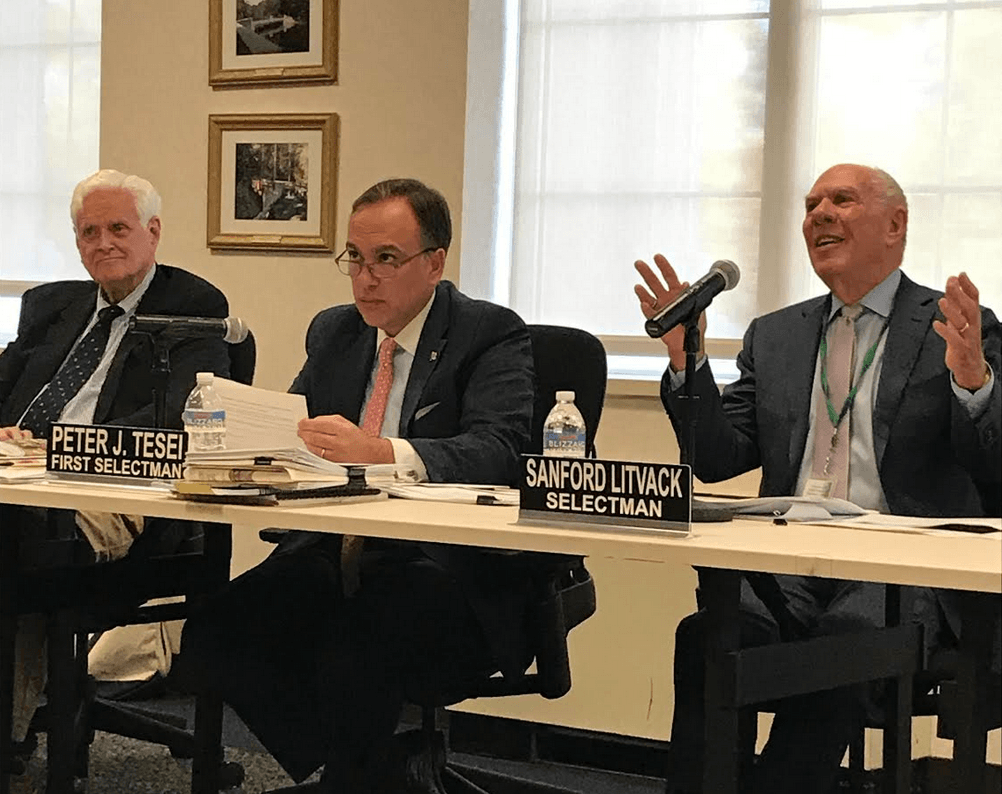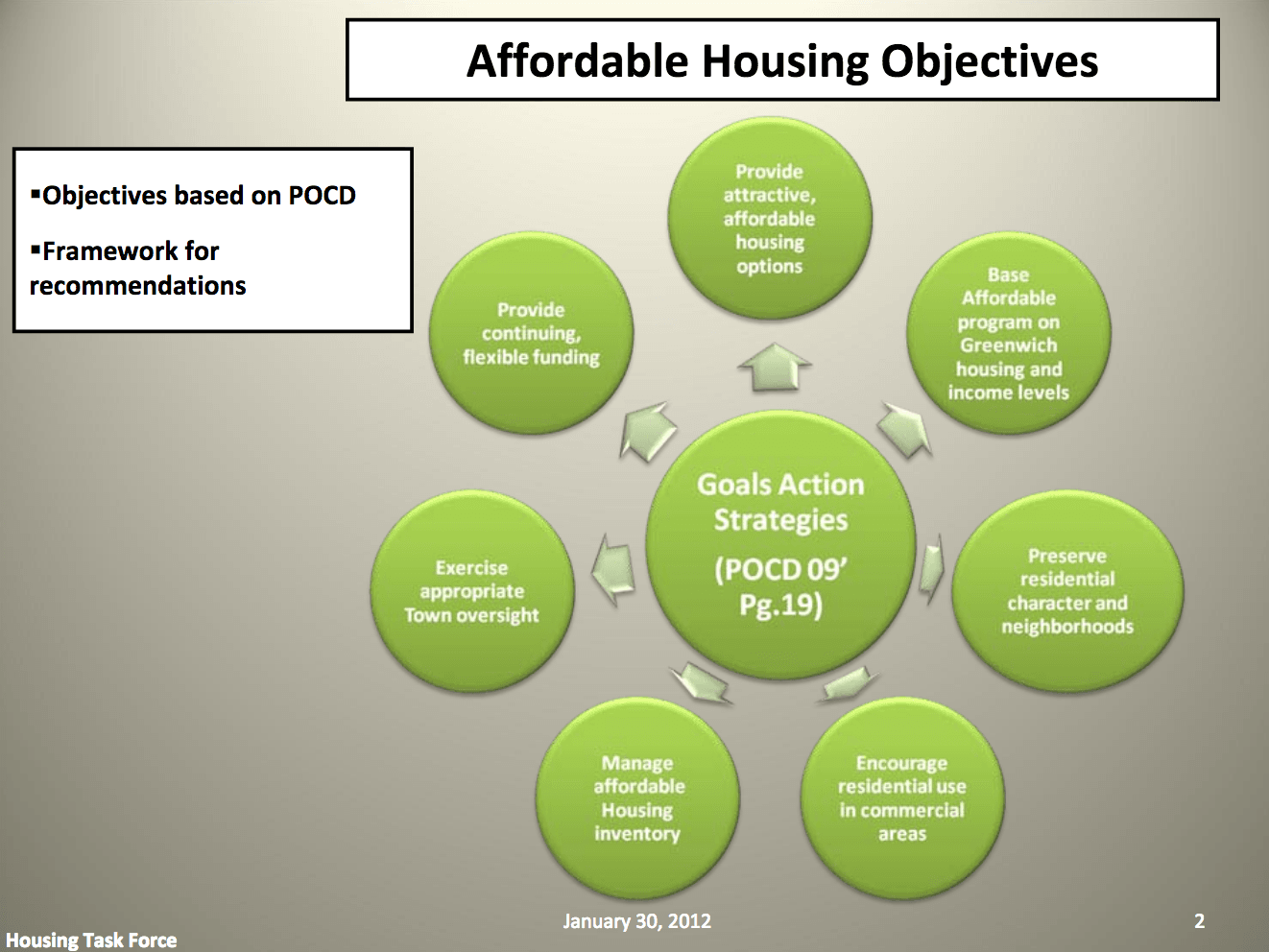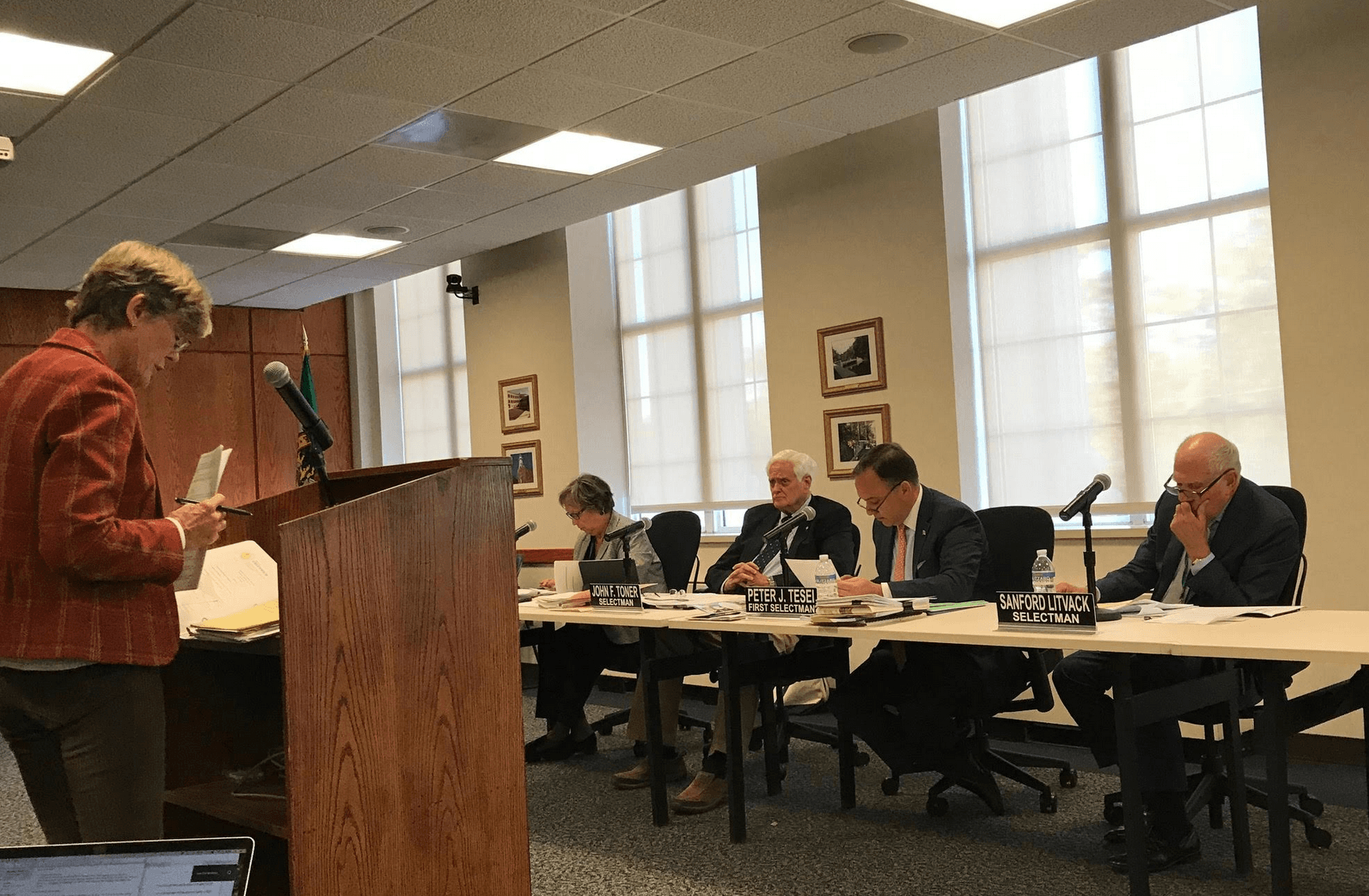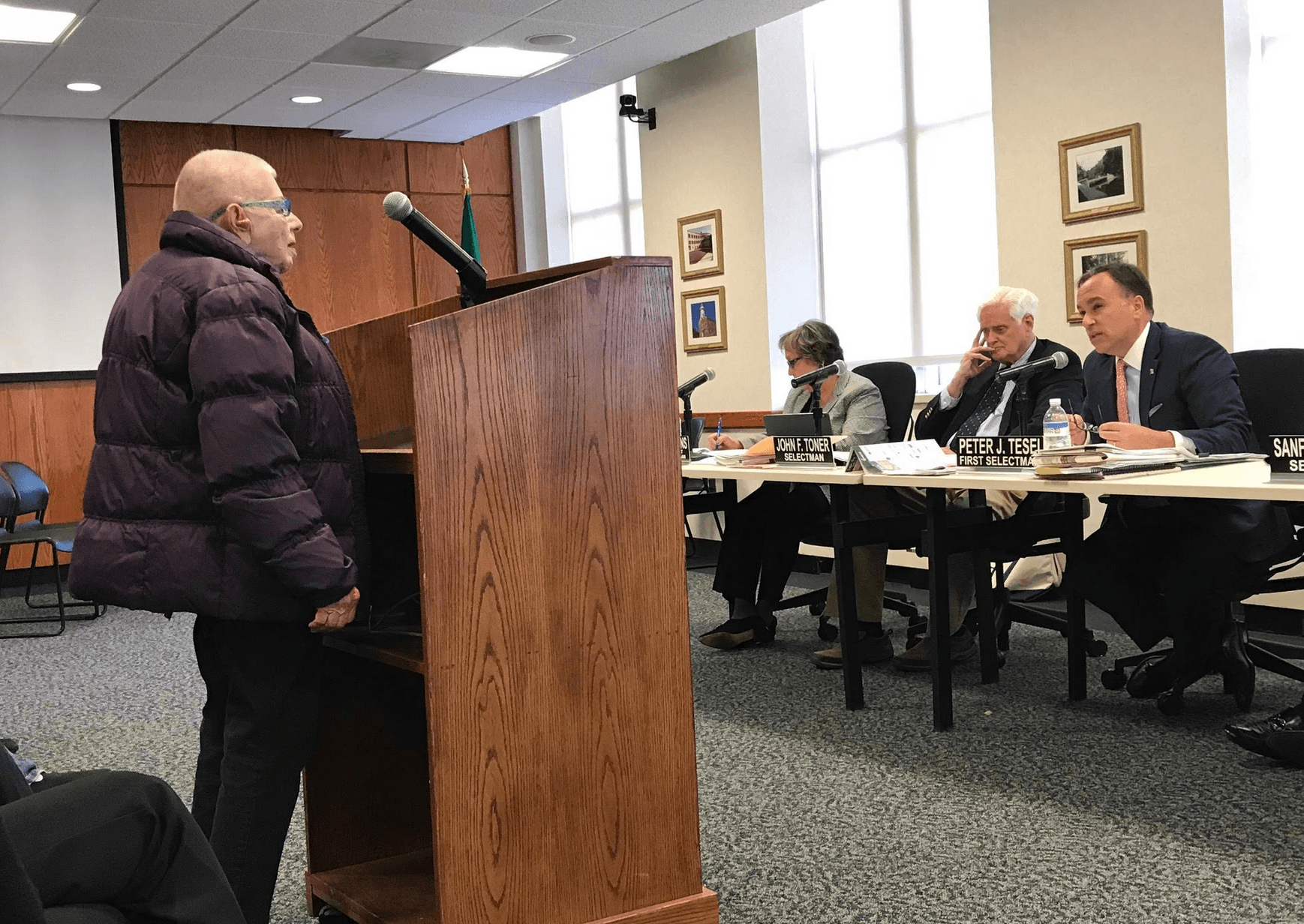On Thursday the outgoing Board of Selectmen, in their last meeting before the Nov 5 election, voted to approve two Municipal Improvements to move forward to town departments.
One is a multistory building for the elderly proposed for the northwest corner of Armstrong Court. This building would feature about 50 elderly units. Only about 10 would be “affordable.” The remaining 40 units would be rented market rate.

The Board of Selectmen John toner, Peter Tesei and Sandy Litvack. Oct 24, 2019
The second MI request moved forward was for Quarry Knoll, located off East Elm Street in downtown, to demolish 50 cottages and replace them with five multi-story buildings for a total of 175 to 225 units, including an unspecified number market rate units adequate to fund the affordable units.
The vote was 2 to 1 with, Sandy Litvack, the lone Democrat on the three person board, dissenting.
Mr. Litvack said he found the MI process a dilemma.
“We are either blessing something or doing nothing. If we’re doing nothing, we’re clearly a potential road block. No one wants to be a roadblock,” he said.
He acknowledged that the Housing Authority had provided a good amount of information since the last meeting including that 185 units of affordable housing have been added to the Town’s inventory since 1989.
There was discussion about the meaning of “affordable,” which varies depending on context.
Anthony Johnson, director of the Housing Authority said his agency does not use the same calculation the State does for 8-30g developments, (8-30g is the State affordable housing statute which gives significant incentives to developers). He noted 8-30g has been leveraged by what many call “predatory” developers in town.
“If we had been allowed to do these things in the past, we would not even have an 8-30g problem,” Mr. Johnson said.

Housing Authority director Anthony Johnson and board chair Sam Romeo. Oct 24, 2019 Photo: Leslie Yager
Mr. Litvack said Mr. Johnson had “a concept,” but hadn’t explained who the potential market for the senior housing proposed for Armstrong Court would comprise.
“You have no facts and yet you’re asking us to approve it (the MI). …If we are approving something, we ought to have facts. What percentage of the senior market are you serving? Me? No. Peter? No.”
Mr. Johnson complained about how much expense there is for the Housing Authority to develop proposals given they might be turned down.
Mr. Tesei said a “roadmap” had provided by the Housing Task Force under Nancy Brown and later under Mary Ellen LeBien.
More from the Housing Task Force is here.

Tesei read aloud these recommendations of the Housing Task Force for the POCD in 2009.
The Housing Task Force (HTF) considered all of the Action Items assigned to it in the POCD in the context of a number of interrelated Greenwich affordable housing objectives that:
•Provide attractive, affordable housing options to meet the needs of the Town’s elderly, moderate-income workforce, and other residents challenged to find affordable Greenwich housing.
•Develop an affordable housing program based on Greenwich’s unique housing market and Area Median Income characteristics. See attached 2011 Area Median Income (Attachment 1).
•Preserve Greenwich’s unique neighborhoods and villages, and residential and open-space character.
•Encourage residential uses in commercial areas to reduce stress on Greenwich’s infrastructure and Town resources.
•Manage the affordable housing inventory to achieve and maintain an attractive and safe living environment.
•Exercise appropriate Town oversight of the affordable housing program, including enforcing regulatory agreements and deed restrictions.
•Provide continuing, flexible affordable housing funding from private and public sources – not necessarily municipal funding.
“I feel very comfortable with what they did and what exists as a result of an open, deliberate, transparent process,” he said. “You’re in a position to execute it. I’m okay with the concept.”
Tesei also said, “Katie DeLuca (director of P&Z) spoke to the State regarding housing equivalency points, and said we are interested in pursuing this. And the fact that the renters are making no more than the area’s median income, and if you agree to deed restrict the units, we could qualify for the moratorium,” he said referring to the moratorium on 8-30g developments.
“You’re not the only ones treated rigorously,” Tesei said to Mr. Johnson, adding that the New Lebanon School MI was scrutinized extensively as far as its location on the property.
Mr. Johnson said the issue was how much money the Housing Authority was spending just to develop proposals.
“Basically you’re opening the door to give us that comfort that the executive board supports it to go forward with the process,” said Chris Bristol, the attorney for the Housing Authority.
Mr. Johnson said in the past the authority spent $600,000 to prepare a proposal that was ultimately turned down.
“I understand you are reluctant to spend the money to get those facts. I’m reluctant to vote on something without the facts,” Litvack replied.

Chris Bristol, attorney for the Housing Authority testified before the Board of Selectmen. Oct 24, 2019
Though the meeting was not a public hearing, and Mr. Tesei said there was no time for public comment, he did not stop former P&Z commissioner, retired attorney Nancy Ramer from taking the podium.
“I wish to speak on behalf of the residents of Greenwich who are not represented at these proceedings – the poor, people with food insecurity, the people who need affordable housing provided by the housing authority,” she said.
Ramer said the authority of housing authorities in Connecticut is found at CGS Section 838 Municipal Housing Projects. CGS Section 8-39 (i) defines a housing project as “any work or undertaking to provide decent, safe and sanitary urban or rural dwellings, apartments or other living accommodations for families of low or moderate income…”
“The purpose of the Municipal Improvement requirement in the state statute is to provide a municipality with oversight over what housing projects a housing authority undertakes” she added.

Attorney and former P&Z commissioner Nancy Ramer testified,”This proposal is not housing for poor people. That is what’s wrong with it.” Oct 24, 2019 Photo: Leslie Yager
She said the intent of the State that the mandate of housing authorities is to provide low and moderate income rental housing and that is “evidence by the fact that CGS Section 8-64a provides that no housing authority “may sell, lease, transfer or destroy” any such housing project unless and until is has obtained the written approval of the Commissioner of Economic and Community Development after a hearing.
“This proposal is not housing for poor people. That is what’s wrong with it,” Ramer said.
“Housing needs to be for those poor people. I know the Housing Authority has gone to be based on state funding based on the rehabilitation of 3 buildings at Armstrong Court and we have heard nothing about them going to the state and being rejected. To allow this to go forward on the basis of almost all the units, at a $3,300 rent…and just five units to be affordable. It’s preposterous and extremely upsetting,” she said. “The reason I’m here is we need to help the poor. This is not okay.”
Ms. Ramer said 3,200 individuals in Greenwich live in poverty (United Way Needs Assessment 2016.)
Also according to the 2017-18 District profile, 1,328 Greenwich public school children receive free or reduced lunch.
She said according to the United Way Needs Assessment 2016, that 7,500 residents qualify for ALICE, which stands for asset limited, income constrained, employed.
“They are the working poor who earn above the federal poverty level, do not qualify for certain public supports and often fall short of affording basic human needs such as food, shelter and medical care,” she said.
Ramer said both the United Way Needs Assessment and soon to be finalized 2019 POCD reflect that the highest priority of the Town is low and moderate income housing.
“In the face of this serious need, it would be unconscionable for the Housing Authority to build market rate housing with a proposed rent of $3,300 a month for a one bedroom apartment and to demolish existing low income housing to construct buildings with vague percentages of low income housing.” – Nancy Ramer
Greenwich has 5.32% of its housing stock qualified as “affordable,” which according to the the United Way Needs Assessment, reflects no growth from 2010 to 2015.
She quoted a memo from Anthony Johnson dated Oct 9, 2019 saying there are 421 families on the waiting list for pubic housing and 100 seniors. “It would take 521 units to meet that need,” she said.
“We are not a social services agency,” Mr. Johnson said. “Our mission is to provide safe and affordable housing. We service the people who live in the community, the entire community. Not just one part of it.”
Jill Oberlander, the chair of the BET who is running for First Selectman, said she searched for backup material to questions the Selectmen had asked about the proposals and they were not available online.
“I was also looking on the Housing Authority site and noticed their audits, which I thought would give us background on their structure, were not updated. Maybe you can provide us that information as well, so we can better understand, as the public, how they are structuring each of their properties. The last report posted was from 2014.”
Oberlander was told they answers from HATG to the Selectmen were not pubic but the Selectmen’s office would email them to her.
Lucy von Brachel said she’d scoured the minutes of the Housing Authority and found nothing to indicate that the residents were aware of the proposals.
“I haven’t heard a thing about outreach to the tenants of these properties,” she said. “It’s very important you refocus on the communities, the residents. Our focus is on your constituents, not these other governing bodies.”
“You can color the conversation by not accentuating all of the acts,” Mr. Tesei said, noting the Housing Authority had increased its representation of tenants on its board.
Ms. von Brachel said she was aware of that.
“The reason the residents are not here is they support the plan. They are over the moon,” Mr. Johnson said, adding that at least 50 units of elderly housing would be returned to Quarry Knoll when it is redeveloped and existing tenants have first right of refusal.
Mr. Johnson said the motives of those objecting to the MI were political. “It’s an election. I know it’s silly season,” he said.
“I take great exception to the suggestion that the question being raised, the data being requested, is about elections or about a ‘silly season.’ You have no basis for that. It is in fact untrue. Do not attribute motives to people,” Mr. Litvack said.

Joan Yankowski, a resident of Quarry Knoll, who is a tenant representative there, asked why it was necessary to tear down all the cottages to construct “big buildings” and lose green space. Oct 24, 2019 Photo: Leslie Yager
Joan Yankowski from Quarry Knoll said she was aware the buildings needed improvement, but she worried about losing green space.
“Could they be renovated instead of just knocking them down?” she asked.
Mr. Tesei said Quarry Knoll is underdeveloped and noted there have been redevelopments that include green roofs.
He said the Housing Authority would work with the residents of Quarry Knoll and neighbors at the private Milbrook community.
“We need to move things forward to get the light of day. This is likely to take several years by the time it goes through the regulatory processes,” Tesei said.
“Just the concept of putting up big buildings?” Ms. Yankowski said. “We only have one little entrance going in and out.”
Mr. Tesei said details like drainage and traffic would be dealt with by various town departments.
“We don’t have a plan, we have a conception. We’re willing to do whatever it takes to make the neighbors happy,” Mr. Johnson said.
Tom Hughes a resident of Overlook Drive in Milbrook for 33 years said a letter had circulated in Milbrook about the proposal and that was the first he’d heard of it.
“There was a proposal similar to this that was rejected in the past,” Hughes said. “It was rejected because of the dramatic impact on Milbrook residents. In the daisy chain of things that will take place as a result of Quarry Knoll going up by 400%, the developer makes money, and we do a good thing by creating housing for those who need it. But the losers are the people in Milbrook.”
“You cannot tell me that my house and the others on Overlook Drive are not dramatically effected by this project,” Hughes continued. “Consider the quid pro quo in Milbrook. Maybe you change the mill rate for people on Overlook Drive. We’re donating the most.”
Mr. Tesei said the Assessor’s office deals with people who say their property values are impacted.
“This is not the final determination. It’s out job to say is this a valid request. Then P&Z will do their job,” Tesei added.
Mr. Johnson said the Housing Authority worked with Milbrook in 2006 and they endorsed a plan.
Alanna Hynes, a lifelong resident of Overlook Drive in Milbrook said, “I feel very strongly that Quarry Knoll was intended to be a facility for seniors, especially low income seniors. We should be able to make a statement that we are trying to serve a specific population. That we don’t have the facts is concerning to me.”
Ms. Hynes said she understood it needed to be upgraded and wouldn’t want her own grandmother to live there.
But, she added, “It’s shortsighted to say that moving seniors from the middle of town to Byram is a viable solution for folks who rely on walking to the senior center and the grocery store. I can attest that it is traumatic for everyone to move, and particularly traumatic for older people accustom to their community to be moved far across town to an unfamiliar neighborhood and away from the services the town generously provides to them.”
I’m not saying this is not, ‘not in my back yard.’ We were all aware it was there when we moved in and felt comfortable that it was providing for a strong need,” Hynes added.
Chris Lagano, a resident of Milbrook said he’d met with Mr. Johnson and Mr. Mardullo, but he wanted to clarify that the Housing Authority met with Milbrook’s board back in 2006 for a previous proposal at Quarry Knoll.
“That was four presidents ago,” he said. “They have not met with the current board. And we have some concerns. …Just as to the size and the scope of the building, those are what we don’t know about,” he said.
Dawn Fortunato, a neighbor of Armstrong Court said when there was lead, asbestos and mold found at the complex, and she distributed flyers to residents, the Housing Authority banned her from the property. Also she said, the day after the last meeting where she spoke, new no trespassing signs were erected at the northeast corner Armstrong Court.
“Please don’t say I don’t care about people because I do,” she said.
Ms. Fortunato also said neighbors just 22 ft from Armstrong court recently had their property tested and it came back with high levels for lead and asbestos. She said she believes the contamination on the Booth cul-de-sac comes from years of fly ash coming from the dump’s incinerators which burned for 38 years, and she believed that impacted Armstrong Court as well.
Allison Walsh, an attorney from Chickahominy, said that the proposed location for the elderly building at Armstrong court was a bad concept.
“It’s the back yard of the people who live there. It has a basketball court and a playground. It’s used for recreation by the current residents. What they’ve done is build new buildings in the front yard. Do you really want to take away their back yard? It’s some of the only green space in this overdeveloped, over paved part of town,” she said.
“I don’t believe the Housing Authority should be doing market rate housing,” Ms. Walsh continued. “It’s one thing to say you can take private financing. It’s another thing to say you can do it for people who aren’t low, moderate or very low income. It’s a legal question.”
Tesei said that Greenwich Close across the street from Town Hall had units set aside for town employees.
“They’ve never been cited for non compliance,” he said. “That was an acquisition given to help generate revenue for those they help subsidize.”
Tesei said Ms. DeLuca approved the general concept.
Mr. Tesei made a motion to approve the MI for Armstrong Court.
“I have come to the conclusion that the MI is a starting point and there are different departments in the town that are very qualified to answer all the objections,” Mr. Toner said. “Therefore I support the motion.”
Mr. Litvack said he would vote no because he struggled with what the purpose of the MI.
“I think the purpose is to get the facts so that when and if it moves on, the facts have been exploited. I’m disturbed that there only five units out of 51 at Armstrong Court. If we’re really trying to deal with need of affordable housing in this town, that doesn’t sound right to me.”
“We don’t know, at $40,000 a year for a one bedroom apartment, I don’t know whose need that fulfills and how many of them there are,” he added. “I understand the Housing Authority’s point that to know that they’d have to spend some money to get the answers and they don’t want to do that….To me you do have to spend some money. This board deserves that information.”